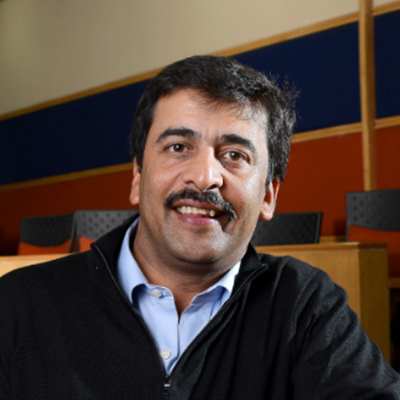A Conversation With Piyush Mehta

Piyush Mehta
Chief Human Resources Officer for Genpact
Genpact is a global professional services firm focused on delivering digital transformation. The company drives digital-led innovation and digitally enabled intelligent operations for clients, guided by their experience with running thousands of processes primarily for Fortune Global 500 companies. Based in New York, the company's 90,000+ employees "think with design, dream in digital, and solve problems with data and analytics."
Providing such advanced solutions requires an enormous, constantly evolving employee skill set. But there was no skills-training program available with the depth, speed, scalability or functionality that Genpact employees needed.
So Genpact built its own.
The company used its next-gen technology to identify 300 granular skills in 60 domains with 1,500 learning assets and then develop learning personas to create a dedicated, internal platform -- which they named Genome -- for in-house experts or knowledge nodes (called gurus) to use as a master/apprentice model to teach each other.
Learning is done in bite-sized, issue-specific chunks that allow employees to gain the skills they need and implement them into their workflow. The gurus oversee the process, and over time, novices who have learned by doing can become gurus too.
As Piyush Mehta, Genpact's CHRO, explains in the following CHRO conversation, Genome's learning architecture "continuously curates, crystallizes and enhances knowledge" that employees need, exactly when they need to know it, the way they want to learn it. And that -- not a gigantic catalog of learning material -- is the key, Mehta says, to the future of organizational learning.
Emond: You and I have been talking about where you're going with learning at Genpact. Tell me about that.
Mehta: The stakes on reskilling are going to be humongous. Skill shortages are and will continue to be a defining factor, we believe, of enterprise competitiveness. The half-life of learned, relevant skills has shrunk down to four or five years, pretty much. And in a world where careers span possibly 50 to 70 years, the number of people impacted is huge.
Therefore, the ability to reskill and leverage learning as an organizational strength will become a massive competitive advantage. For employees who ask themselves, "What do I do next?" and "Do I have the skills for the job I want?" providing an opportunity to reskill is also very appealing. So, it helps us as an organization and it helps individuals at a personal level. But we need a new architecture for reskilling.
Emond: Companies struggle to get enough of their employees to find the time to do the reskilling. CHROs of very large and respected companies are telling me they plan to just hire people who already have those skills. What's your response to that?
Mehta: I do have a slightly different view on this. For us, it's not about buying talent, it's about building talent.
Any solution that has to be scalable, has to be about building talent.
At the end of the day, hiring for skills is only going to cause a further spiral in the market for an asset that is, in any case, limited. You're not adding to the broader ecosystem by going out and buying talent. To really make a sustainable impact and competitive advantage, it's got to be about building talent.
And you are right -- there is clearly a disconnect. Employees want training. Executives say that they are providing it. But the needle doesn't move.
Emond: What do you attribute that to?
Mehta: At the core of this issue, learning and development organizations struggle with the speed of technological change coupled with workers who feel they've learned all they need or want to. The solution has got to be a paradigm shift from what HR practitioners are used to. We need to redefine employee reskilling away from the conventional approach of learning. We need a collective intelligence architecture that continuously curates, crystallizes and enhances knowledge.
It will mean changing the conversation from educating every individual through L&D to actually reskilling groups of people who work together to increase their collective intelligence. It's about going from a narrow, domain-oriented training to focusing on the basics of skills that others have, then enabling people to work together.
People learn better from other people, so a "master/apprentice" model works well. But we've got to avoid mixing intrinsic and extrinsic incentives.
Making learning mandatory isn't effective. I think we've got to come to terms with the fact that we are dealing with adults here. We are not dealing with schoolchildren.
Mastery of these new skills is something that people should aspire to in any case.
Emond: What's your approach to reskilling adults?
Mehta: Our overall initiative is called Genome because, like DNA, it's fundamental. Learning has to do with the way we are wired. It has to do with the way the organization's culture is wired. To us, Genome articulates the combination of the science of learning with new operating models based on MIT's Center for Collective Intelligence work. We conceptualized this with design thinking -- the key personas of learners -- and with the belief that learning is an intensely personal journey.
Analysis of the self is the fundamental driver for this because it indicates the skill sets people want to learn. So, Genome's reskilling architecture has four pillars collectively called "BITS," which stands for Because, Immerse, Transform and Solidify. Because is about individual skills assessment. Immerse refers to the self-learning that individuals undertake, based on the curated material. Transform is all about the knowledge-nodes connections, the gurus connecting their expertise to people who need it. And the S is for Solidify, which is learning through doing.

Emond: Back up a bit. How do people know which skills they lack?
Mehta: Early on, we identified over 50 skills for the future -- artificial intelligence, machine learning, agile thinking, storytelling, people leadership skills, etc. We sent this list out to 10,000 of our employees, and we said, "Folks, identify for yourselves which of these skills you would like to learn. And once you've done that, tell us if you're a beginner, intermediate, proficient or expert in that skill."
That skill inventory is based on a capability framework that defines the actual proficiency level for skills and capabilities for all the relevant roles in Genpact. About two-thirds of the people who volunteered themselves were also selected by the analysis to be gurus. And we use advanced network analytics to understand the structure of the networks where the new knowledge is present and is shared, which is one way to get an idea of the proficiency of our gurus.
And those gurus are very important. We ask them to volunteer their expertise, to create their own materials, to help others in the organization learn. Which is what creates such fast scalability. You know, lack of data is not the struggle. The struggle for organizations is scaling up -- contextualizing learning opportunity data insights to the organization and its stakeholders in an agile format. That's why the master/apprentice model is so useful. It's scalable and agile.
And adults need contextualization, or they struggle to understand and retain concepts that are not connected with their existing knowledge. Natural language processing, for example, is hard to understand in a vacuum but much easier to conceptualize when you understand how it works in your job domain. This model allows workers to learn by doing, to contextualize the material to their own work in the flow of business. So, they can learn what they need to know quickly as they get ready for the next task, or phase of a project, or even just a meeting.

Multiplying the Impact of Individuals' Knowledge
Master gurus ...
- identify and nurture the guru network and the expert network
- infuse relevant content
- direct thought leadership
- run initial seminars aimed at learners (especially experts)
- own the skill agenda
Gurus ...
- contribute thought leadership and content curation/creation
- run seminars (especially non-expert-level)
- daily engagement with apprentice and teams
Knowledge managers ...
- filter, stage, standardize, tag and refresh content
- cross-pollinate knowledge across guru networks
Experts ...
- support learners on learn-by-doing opportunities
Emond: How long have you been running Genome?
Mehta: We launched a pilot last November and we're implementing it organization-wide now, but we're already seeing impact. Tiger [Genpact CEO "Tiger" Tyagarajan] did our quarterly global town hall today and one of the agenda items was recognizing eight gurus who have done the best job out of our 50 gurus. Tiger also recognized the individual who completed the maximum learner hours, and called him up to speak about why and how he's learning.
To make BITS a CEO agenda, to take it across the organization, you have to make heroes out of the gurus. And then Tiger said, "I have enrolled in the skill set on AI and I have already done 40 hours of learning. And when I go from a beginner to an intermediate, I will publish that across the organization." That creates a very different example. The whole objective is to make this bigger than Ben-Hur, and that is how you do it.
Emond: Explain how the gurus operate.
Mehta: I'll give you a little bit of personal experience. So, one of the skill areas we've defined is people leadership skills. Within people leadership, I am the guru for conflict management. One of my direct reports is the master guru for the entire people leadership piece, so I report to her for this particular initiative. But I own the conflict management subskill set so I've pulled together a team of people and we are leveraging all the material on conflict management that is available out there. But at the same time, I'm using my personal experiences, recording videos with people whom I believe manage conflict well, especially in client situations. Like where you are negotiating contracts, where you have potential issues in delivery, where the client has been a difficult one, things like that. And we record personal experiences, put the videos up there, and we build the learning materials around that using the relevant academic research.
The whole idea is to create a bite-sized conflict management curriculum. It's not about sitting down and learning for six hours a day or six hours a week at one stretch. It's about, "I have 10 minutes; how do I quickly look up some stuff on this, and then go talk to a client?"
As an example, we recently had challenges on a particular process. And as with all challenges, there comes learning. So, Tiger asked Gianni [Gianni Giacomelli, Genpact's Chief Innovation Officer], who owns the Genome piece along with me, to put together a one-page case study to summarize the issues and learnings. Within 24 hours, we had this case study up on the company intranet. And employees who now look up material on the "client relationships" subskill have access to and can learn from this.
Emond: How did you arrive at the 50 skill sets?
Mehta: It wasn't random. Our understanding of operational processes, as well as our collaborative, design thinking-based methods, helped us draw up a list of necessary skills. Then we identified the skills that automation will replace humans in, and skills that humans must hone. From that list, we asked people which of the skills they most need. But the skill sets may change -- the interesting thing is those 50 skills are dynamic. It might have to become 45 or it might have to become 52, depending on what we believe needs to get added to the pie and what needs to get taken out.
I have to tell you that the guy who conceptualized this whole thing is Gianni. He owns the thinking on this, because conventional HR people like me probably would not have been able to create a model of this sort: quite forward-looking, but simple at the same time. Actually, in the beginning, one of the concerns was that if you're going to ask 10,000 people in a pilot study -- and soon after, 90,000 organization-wide -- to create their own skill inventory and to say whether they're good or whether they're not so good at something, how do you know they are correct?
And then we stopped and said, you know, do we really want to be in that business of checking and counterchecking? What we want to do is give people a chance to evaluate themselves for themselves. Then, within the different proficiencies that we create within the skill areas, if someone goes from beginner to intermediate to proficient then to expert, and if the material is curated well, they'll learn to evaluate their proficiency in an area for themselves. And if I am not an expert at this stage, if I'm only proficient or intermediate, I'll find out pretty quickly -- that calibration and recalibration will go on in a dynamic fashion.
Emond: Genome will never be done, will it? Because there will always be more to teach.
Mehta: That is correct. But gurus have a lot of help. Our network analysis identified knowledge brokers who build connections between the communities of interest. And experts who are interested in becoming gurus help us crystallize and curate new knowledge and scale it up.
But the learning comes through doing, always. The approach goes back to basics of learning, to the science of what works, which makes it very simple to do. When learners are ready to use the skills they've developed, the gurus lightly supervise their work on actual projects. And when the project is completed, gurus, team leaders and HR coaches assess the work and "certify" the learner. It's a collective-intelligence-based reskilling machine that sources, crystallizes, propagates and absorbs knowledge. So the workforce, and Genpact, is able to adapt to a continuously changing world better, fill in the talent gap more efficiently and drive real-world innovation at scale.

Network Analysis to Identify Nodal/Central Knowledge Experts
First, survey respondents indicated who they connected with for specific Genome-oriented skills. Then we built the Network Graph. From that we calculated centrality. Two human network analysis algorithms differentiate between thought leaders with strong followerships and hyper-connected knowledge brokers.
Emond: You also told me once that this had the secondary benefit of significantly reducing your learning budget.
Mehta: That's right. It wasn't why we created Genome, but it's been a nice outcome. And it's not so much because we're saving on outside content purchases, but because we have practically banned classroom training. Travel for training is banned. It's all virtual and it's all in small bites. So we'll probably do 5% of the outside training we used to.
Emond: A lot of CHROs are kind of frustrated -- they say, "We can't get our managers to do a one-hour online module, but if we tell them that there's a three-day program at Harvard, suddenly everybody's calendars are wide open."
Mehta: That's not untrue, Larry, at all, given the way traditional learning has been run. Look, if I'm forcing someone to do a one-hour virtual learning program that they see no benefit in, they have no internal drive to do it. Which means they will not want to do it. Which means we are not solving for the fundamental problem, their lack of skill. We need to step back and apply skills to the individual's career path. And when they see that what they're going to learn is relevant, that it is fundamental to their career growth and their performance, their response is very different from what we've seen in the past.
And people do understand the pace of change has become just electric. The future is not clear, and as the future is not clear, people have to find ways to acquire new skills to remain relevant.
Emond: Other than the recognition, like at the town hall, are you doing positive or negative reinforcement? Or financial rewards?
Mehta: There is no negative reinforcement. Intuitively, I don't like kicking people in the butt. I don't think it works very well because the motivation to learn is then external. That said, if half of your people are not stepping up, then I think you need to look at the dynamics involved, the other ecosystems.
So at this stage, Genome is only about positive reinforcement; it's about giving learners a very high level of visibility within the organization and externally as well, through Gianni and myself and Tiger and all our client-facing leaders. I think the external and the internal momentum that we've been able to build has been massive. This is part of our DNA. But organizations, especially HR organizations, have to get away from the business of checking and certifying and monitoring. We need to start treating people like adults. Because the intention, I think, of every human being is not to scam the system, but to learn.
Explore other CHRO conversations:
- Amazon CHRO Beth Galetti
- Dignity Health EVP and CHRO Darryl Robinson
- Sanofi CHRO Roberto Pucci
- Microsoft CHRO Kathleen Hogan
- Mayo Clinic CHRO Cathy Fraser
- Roche CHRO Cris Wilbur
- ABB CHRO Jean-Christophe Deslarzes
- Roche CHRO Cris Wilbur and Global Head of Talent Innovation Tammy Lowry
- Schlumberger HR Chief Gavin Rennick
- Huntington Ingalls Industries CHRO Bill Ermatinger
- UBS Group Head Stefan Seiler
Jennifer Robison contributed to this article, which was based on an interview conducted by Larry Emond.


